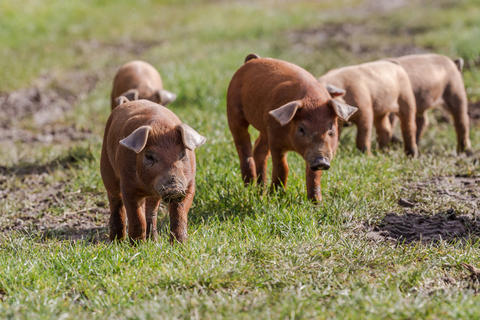Early detection of sick pigs in organic systems
The use of synthetic substances in organic pig production is tightly controlled by the standards established by the USDA National Organic Program. When a sick pig is treated with antibiotics, it cannot be sold as a certified organic product according to the USDA National Organic Program.
Read also: General care for the pig
As a result, maintaining animal health through the prevention of disease and early detection of sick pigs is paramount to successful organic pig production. Disease prevention can be achieved through strengthening biosecurity, enhancing innate immunity by reducing stress, and by implementing vaccination programs.
By detecting sickness early and providing proper care, sick pigs may recover without using antibiotics or other unapproved treatments, allowing them to remain in the organic herd.
Early signs of sickness
 Learn More
Learn MoreRecognizing early signs of sickness is the key to early detection. When a pig shows signs of a disease, such as coughing, diarrhea, fever or lost appetite, early signs of sickness have been missed and it may be too late to save the pig without antibiotics treatments.
As noted by Lucina Galina, DVM, early signs of sickness usually appear days before the symptoms emerge and include changes in behavior, appearance and temperament of the pig.
1. Changes in behavior
According to Li and Millman, example changes in behavior are:
Less active and spending more time resting.
Lying apart from other pigs.
Lying on the belly with drooping ears.
Huddling and shivering.
Walking with arched back and drooping tail.
Sitting like a dog with labor breathing, thumping or coughing.
A healthy pig usually maintains the same daily pattern of behavior and remains alert and active.
2. Changes in appearance
According to Millman and Gemus-Benjamin and Kramer, changes in appearance can include:
Gaunt and lacking energy, melancholy appearance (listlessness), drooping eyes with discharge.
Rough, messy or standing hair.
Skin color changes to pale, blue or red in white pigs.
Dry snout, sometimes with cracks.
Dirty rump with signs of diarrhea.
Sunken flanks.
3. Changes in temperament
According to Gemus-Benjamin and Kramer and Australia Pork, changes in temperament may include:
No interest in people, pen-mates, feed or water.
Little response to handling.
Less aggressive, less social interactions with other pigs.
No vocalization or playing.
Early detection of sick pigs is crucial to the health management of organic pigs. Changes in behavior, appearance and temperament of pigs are early signs of sickness, but are often subtle and easily overlooked.
Read also: Six Keys to Promoting nursery pig health
It is important to spend time each day observing individual pigs closely, to recognize and understand changes in pigs and the environment surrounding them. It is an essential and worthwhile investment of time to detect early signs of sickness.
Pigs are sometimes capable of self-repair, according to Australia Pork and The Pig Site. When provided with good nutrition, a comfortable environment and proper care, pigs with early signs of sickness may fully recover after the disease has run its course.
Contributed by The pig site
For more information and updates join our WhatsApp group HERE
Follow us on Twitter HERE











